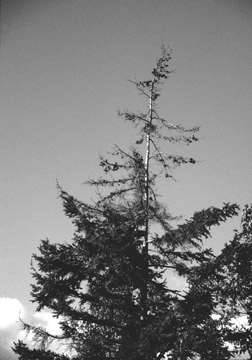The great ice storm of January 1998 was the worst disaster Maine has seen in a long time. However, while we humans suffered greatly from the storm, with more than 20 lives lost, billions of dollars of damage done throughout the region, and loss of electrical power for as long as two weeks for some people, by far the greatest and most enduring effect of the storm is the extensive damage done to our trees and forests. As everyone knows, trees were decimated throughout the area affected by the storm, losing branches and major limbs or falling down completely. Thousands of shade and ornamental trees in yards and along our streets were lost, some sugarbushes were completely destroyed and our forests may not be the same again for decades. Here in Washington County where I live, one can look out from hilltops and see many large swaths of Larch and Aspen where virtually every tree has lost its top. As one drives through the landscape, the fresh scars of missing limbs are visible on trees everywhere one looks. In the vicinity of Augusta and areas to the east the damage was even worse, with large sections where virtually every tree seems to have suffered major damage. However, this massive damage to our trees cannot simply be blamed on the ice. Other far more insidious factors contributed considerably to the disaster. Naturally, heavy ice is always going to bring down some trees and limbs, but previous damage and stress to our trees and forests from air pollution made things much, much worse than they would have been otherwise. Not coincidentally, the species of trees most badly damaged by the weight of the ice - Maples, Ash, Birches and Aspens - are among the species of trees that were exhibiting the worst air pollution damage long before the storm struck. 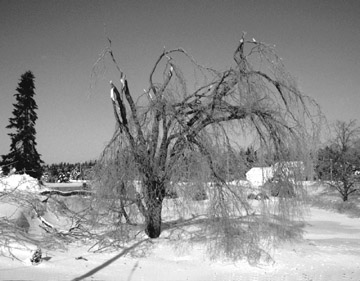 Over the last two years, environmentalists across the state have focused much attention on the destructive clearcutting and overcutting of our forests by industry, and rightly so. But as this storm has made abundantly clear, poor forest management practices are not the only factors affecting the health of Maine's forests, and ultimately may not even be the most important factors. Even if clearcutting, overcutting, the spraying of herbicides and other poor management practices were to be stopped tomorrow, there still exists the distinct possibility that Maine's forests would eventually be destroyed by air pollution. Back in the 1980's we heard a lot about acid rain and its effects on mountaintop forests and lakes throughout the northeast, but since then the issue has largely dropped from the public eye. In 1990 Congress passed amendments to the Clean Air Act, which called for reductions in emissions of sulphur dioxide and nitrogen oxide to deal with the problem of acid rain. With most Americans' concerns about the problem allayed, the issue largely slipped from public consciousness. Unfortunately, the 1990 amendments to the Clean Air Act were not strong enough to sufficiently reduce acid rain, but even if they had been, acid rain is only one aspect of the pollution problem facing our trees and forests. 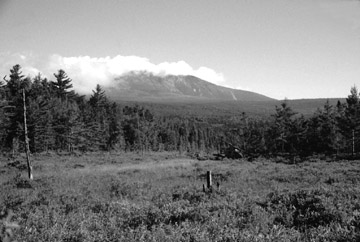 The health of our trees and forests has continued to decline. The first reports of acid rain damage to trees in the Northeast dealt with forests on the upper slopes of some of the higher mountains of the Adirondacks in New York and the Green Mountains in Vermont. These high peaks are the first to intercept the pollutant-filled rain clouds arriving from the mid-West, where factories and coal-fired power plants generate a large part of the pollutants responsible for acid rain. Now, however, if you know what to look for, the effects of atmospheric pollutants on our trees can clearly be seen throughout the region. Trees generally die from the top down. The first visible symptom of decline is usually a thinning of the foliage on the uppermost branches. As the years pass, the tree's crown becomes more and more transparent. Eventually, dead branches can be seen projecting from the crown. The foliage begins thinning out in the middle layers, dead limbs appear, maybe a large limb or two break off in an ice or wind storm, then the lower foliage begins thinning out, and finally the tree breaks off or blows over in another storm. Unfortunately, disastrous ice storms aside, trees generally die slowly, and, this process can take a decade or more. This is unfortunate because the change is subtle enough from year to year to go largely unnoticed. 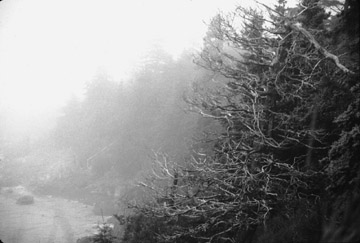 Aside from the mountaintops, the worst pollution-caused tree damage in Maine can be seen along the coast, and particularly on exposed headlands and offshore islands. Here the effects of atmospheric pollutants can be seen with virtually every species of woody tree and large shrub. Like trees on mountain tops, the trees on exposed headlands and offshore islands are already exposed to heavy environmental stresses. On mountaintops the trees have to deal with strong winds and very cold temperatures while on the outer coast they have to deal with strong winds and salt spray. And while the mountaintops are often enveloped in clouds, the offshore islands are frequently cloaked in fog. The rain in our area is now three times as acidic as it was in pre-industrial times, but the coast's abundant fog can be 10 times as acidic as the rain. The trees in both mountaintop and exposed coastal environments are already living at their limits and any additional stress, such as atmospheric pollutants, can be enough to tip the scales against them. Two species of northeastern trees, Sugar Maple and Green Ash, had been hit especially hard even before the ice storm, with virtually every individual exhibiting the symptoms of slow death. In southern New England, where Green Ash is more abundant than it is in Maine, many woodlands have been decimated. It is difficult now, with all the fresh storm damage, but as you drive Maine's roads in winter, look for the preponderance of dead limbs on these two species of trees. Then in summer, look for the transparency of their crowns. If a Sugar Maple exhibits more than 15% dieback or more than 55% crown transparency, it can be considered to be in trouble. Do you remember back when Sugar Maples would first began to turn orange in September? As a symptom of their poor health, now the first orange leaves regularly begin to appear on these trees in mid-late August. 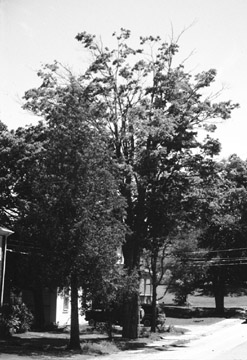
Both Sugar Maple and Green Ash are commercially valuable trees, so their loss will be economic as well as aesthetic. Green Ash provides us with wood for things like tool handles and oars, while Sugar Maple provides us with a valuable wood, maple syrup, and the brightest colors in the fall foliage display. Before the ice storm, some maple syrup producers in Vermont and southern Ontario had already experienced an 80-100% mortality of their Sugar Maples. In addition to Sugar Maple and Green Ash, crown-thinning is especially noticeable on Red Spruce, Red, Silver, and Mountain Maples, Paper and Heart-leaved Birch Birch, Quaking and Bigtooth Aspens, and Lombardy Poplar, with a large percentage of the individuals affected, but the symptoms can be observed on most species of trees in Maine.
The human-induced pollution problems affecting these trees are myriad. To start with, the acidity of the rain is caused mainly by sulphur dioxide, which comes largely from the burning by power and industrial plants of fossil fuels containing sulphur and from nitrogen oxide, which comes largely from automobile exhaust. The sulphur dioxide reacts in the presence of sunlight to produce sulphuric acid and the nitrogen oxide mixes with moisture to form nitric acid. When deposited on the soil, these acids leach away important mineral nutrients in the soil such as calcium, magnesium, phosphorus and potassium. The acidity also makes toxic aluminum in the soil more available to the trees. 
Ground level ozone, also caused by car exhausts, is another primary culprit in forest decline. The ozone damages the chlorophyll in plants, thereby reducing photosynthesis and growth. Another serious problem is airborne toxic metals, such as cadmium, zinc, lead, copper, arsenic, barium, chromium, nickel and mercury, in the rainfall. When materials containing these heavy metals are incinerated, most of the metals go up the stack and out into the atmosphere. More mercury enters the atmosphere simply from burning coal, the same coal that produces sulphur dioxide. The unnatural acidity of the rain makes these metals more soluble, more concentrated and more harmful to the plants, damaging their immune systems. Then there are substances like pesticides (including herbicides, chemicals designed to kill plants), carried by the wind from aerial spraying operations and dioxins from incinerators. To give some idea of what the trees are dealing with, German researchers have detected some 400 synthetic organic compounds in a single cubic meter sample of air! In actuality, our rain and fog have become a toxic stew, with the pollutants acting synergistically on our trees in ways we are still far from fully understanding. Finally, on top of all those threats, there is ultraviolet-B radiation from the thinning of the ozone layer, yet another suspected culprit in forest decline. The results of research at the Hubbard Brook Experimental Forest (HBEF) in New Hampshire, published in the 12 April 1996 issue of Science, have disturbing implications for Maine forests in general. Researchers at HBEF found that since 1987 forest growth "has declined unexpectedly to a small rate" due to chemical changes in the soil. The HBEF is very similar to the forest covering most of northern Maine, so it is reasonable to assume that similar declines in growth have occurred here, as well. One of the first measurable effects of pollution damage to trees is a slowing down in growth. This occurs well before there are visible signs of damage, so it might also be reasonable to assume that this decline in growth is just a first step towards widespread forest death. While this might seem like a radical statement, this is exactly what has already happened over large areas of Eastern Europe. The latest U.S. Forest Service inventory of Maine forests, published in the summer of 1996, showed that industrial forests were growing not a half cord per acre per year, as they have traditionally, but only a sixth of a cord. This discrepancy has been blamed on industry's management practices, which have undoubtedly played an important role. But how much of this difference is due to poor management practices and how much is due to pollutant-caused slower tree growth? What happens to forest management plans and our forest products industry if predictions of tree-growth do not take into account the slower growth brought on by airborne pollutants? 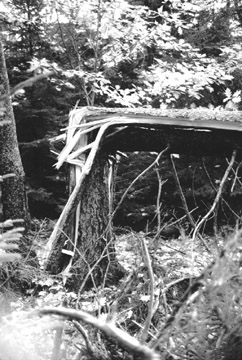
One criticism often leveled by opponents of stricter air pollution standards is that acid rain or other pollutants don't kill trees, that they are actually killed by cold winters or by insects or fungus or some such agent. In a sense these critics are correct - it is true that cold or insects or fungus or some other pathogen is often the ultimate cause of tree death rather than pollutants. But one might fairly ask why in the latter part of this century are so many pathogens suddenly having such a tremendous effect on so many species of trees. If just one or two species of trees were suffering a decline in eastern North America, maybe it would be acceptable to simply blame the weather or some pathogen and dismiss the problem as unfortunate but unavoidable. But that is hardly the case. Instead, what we are witnessing across most of eastern North America is a pandemic of tree death. We need to take the wider view and look on these pathogens as representing only the proximate causes of death, and see forest decline and tree death across eastern North America for the pandemic that it is. Our industrial society with its attendant air pollution is slowly killing our forests, as it has the forests of eastern Europe, weakening and stressing trees, and making them more susceptible to cold winters and attack by pathogens. A good analogy can be made between acid rain and AIDS. You don't die from the HIV virus, you die of the diseases you contract because of your depressed immune system. The same holds true of atmospheric pollutants and trees. It is often not the pollutants that kill the trees but the insects, viruses, fungi, or bacteria that attack once the trees' overly-stressed immune systems are weakened. There is much that can be done to begin to solve the problem. To start with, there needs to be much greater media coverage and public education on the issue. Then, on a personal level, we can limit our own use of automobiles and other gasoline-burning vehicles and tools (ORVs, ATVs, snowmobiles, outboard motors, jet-skis, lawnmowers, leaf-blowers, and chainsaws). Beyond that, we can push for tighter air quality controls on automobiles and industry, including incinerators, in Maine. We can also push for development of a statewide system of public transportation. And, since much of our air pollution originates from beyond our state boundaries, we can pressure Congress for tighter federal air quality controls. 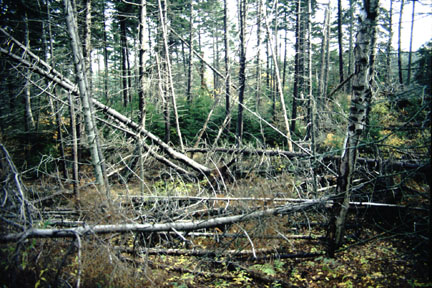
In Germany the term waldsterben - or forest death - is now a household word. Is that what we want here? Is this trend of slow forest death what we want for our children's future? To quote ex-West German Chancellor Helmut Kohl, "If we do not succeed in saving our forests, the world in which we live will be changed beyond recognition." March 1998
For more about acid rain and Maine's forests also see Cleaner Air, Stronger Trees, Healthy Lakes by Michael Hamilton More suggested reading: The Dying of the Trees: The Pandemic in America's Forests, by Charles E. Little, Viking, New York, 1995 'Long-Term Effects of Acid Rain: Response and Recovery of a Forest Ecosystem', G. E. Likens, C. T. Driscoll and D. C. Buso, ScienceVol.272, 12 April 1996, pp.244-246 'Damage in Trees Tied to Heavy Metals in Air', Jon R. Luoma, The New York Times, May 7, 1996 |

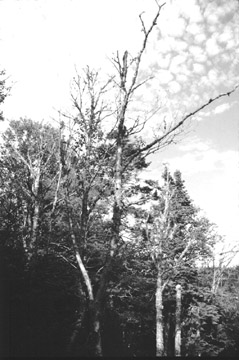 Dead
Paper or Heart-leaved Birch along the upper Bay of Fundy shore
in New Brunswick, an area especially hard-hit by acid rain. Photo
by Paul Donahue.
Dead
Paper or Heart-leaved Birch along the upper Bay of Fundy shore
in New Brunswick, an area especially hard-hit by acid rain. Photo
by Paul Donahue.